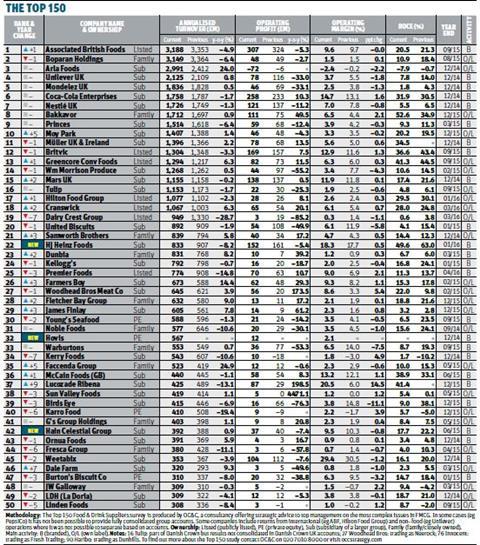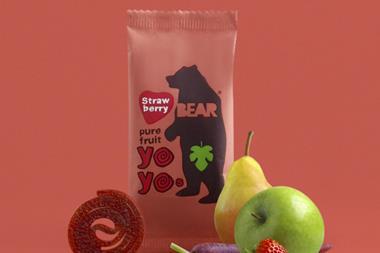Can a post-Brexit UK provide fertile ground for growth among UK manufacturers?

As the saying goes, be careful what you wish for. UK food and drink producers under siege from stagnant growth, falling prices and tightening margins have been desperate for these grim market fundamentals to change. But the shock Brexit decision has shaken up the landscape for these suppliers so profoundly it will be years before the after-effects are fully understood.
To some Brexit can create a newly fertile land primed to generate growth. For others it has irresponsibly scorched the earth and set the fruits of labour back years. What does seem certain is that looking to past trends is no longer a reliable guide to the future.
| Rank | Company Name | Turnover (£m) | Turnover Growth (%) |
|---|---|---|---|
| 1 | Associated British Foods | 3,188 | -4.9% |
| 2 | Boparan Holdings | 3,149 | -6.4% |
| 3 | Arla Foods | 2,991 | 24.0% |
| 4 | Unilever UK | 2,125 | 0.8% |
| 5 | Mondelez UK | 1,836 | 0.5% |
| 6 | Coca-Cola Enterprises | 1,758 | -1.7% |
| 7 | Nestle UK | 1,726 | -1.3% |
| 8 | Bakkavor | 1,712 | 0.9% |
| 9 | Princes | 1,514 | -6.4% |
| 10 | Moy Park | 1,407 | 1.4% |
That recent past is characterised by an ever-intensifying pressure on the UK food industry, with the big four hit by falling sales, and now suppliers following suit.
Across The Grocer/OC&C Top 150 last year revenues declined for the first time since 2001, dropping by 0.1% and ending a four-year period where manufacturers were outpacing retailers on growth.
With margins also close to historic lows even before the disorder unleashed by Brexit, the industry is “a little punch drunk from a number of tough years” according to OC&C head of consumer Will Hayllar.
“It’s a picture of attrition,” adds Premier Foods CEO Gavin Darby. “There has been an awful lot of cost cutting, rationalisation and factory closures, but it frankly hasn’t been enough. It’s not a sustainable environment.”
The culprit is sector-wide deflation. In the early summer The Grocer Price Index found year-on-year grocery prices down by more than 3%, driven by the intense supermarkets price war combined with a slump in commodity and input costs, meaning the Top 150 are having to hike sales volumes just to stay above water.
A cure of sorts may be around the corner. None of us know when Brexit will happen or what it will look like, but the collapse in the value of the pound, losing well over 10% against the euro and dollar since the vote, will mean food prices have to go up because of the higher relative cost of commodities and imported inputs. The Bank of England has forecast a rise in food inflation over the rest of 2016, with OC&C calculating a 15% sterling depreciation should lead to UK food inflation 5% higher than global food inflation. So if nothing else, Brexit changes one of the key underlying dynamics causing such a headache for UK food producers. “The current health of the UK food and drink patient is pretty poor at the moment,” says Hayllar. “In some ways that bit of a jolt that Brexit creates does present an opportunity to try to reset things and benefit through that change.”
”Brexit changes one of the key underlying dynamics causing such a headache for UK food producers”
So the return of inflation is cause for celebration? Not so fast. Inflation is likely to cause as many problems as it cures.
A period of low commodity prices should theoretically have eased the pressure on suppliers’ bottom lines even if top-line growth were hard to come by. But across the Top 150 margins remained flat at 5.3%, well below the 6.4% long-term average, hovering near the low of 5% not seen since the mid-1980s.
With margins already wafer-thin, manufacturers have perilously little slack to absorb higher input costs, meaning they have to pass that inflation on to retailers and consumers. “I don’t think there is any doubt the food industry will see higher costs coming through to manufacturers, which we will need to recover,” says Bakkavor CFO Peter Gates. “We are already in discussions with customers and I would guess some of that will feed through to consumer prices.”
There is no guarantee, though, that consumers and retailers are willing to stump up for these higher costs. A previous period of commodity inflation in 2007/08 saw producers and retailers absorb just £0.1bn each of £5.7bn commodity inflation, but in the second wave, in 2012, producers were taking a £0.3bn hit and retailers a huge £1bn of the £3.3bn inflation.
Given the increased presence of the discounters and with consumers now used to lower prices, the industry may struggle to get consumers to foot the bill.
Top performers
Bakkavor
Turnover: £1.712bn (+0.9%) ● Operating margin: 6.5% (+2.1ppts)
The own-label chilled foods giant has shed its unprofitable fresh fruits factory and instead invested in automation and new routes to market. Performance has been boosted by strong growth in the US and Asia.
Müller
Turnover: £1.396bn (+2.2%) ● Operating margin: 5.6% (+0.6ppts)
Muller has transformed its scale in the UK with the acquisition of Dairy Crest’s milk business and previously successfully integrated Robert Wiseman with cost cutting boosting margins. Investment in new products have also improved profitability and maintained volumes.
Faccenda
Turnover: £523m (+24.9%) ● Operating margin: 2.3% (-0.6ppts)
Almost half Faccenda’s £100m revenue growth is owed to its 2014 acquisition of Cherry Valley Foods. Strong organic growth has included successfully embedding its 2012 Cranberry Foods turkey acquisition, while investment at Telford is building its convenience range.
Finsbury Food Group
Turnover: £257m (+45.8%) ● Operating margin: 3.7% (+0.1ppts)
The highest growth rate in the entire Top 150 has been driven by strategic acquisitions, with deals for Fletchers Bakeries and Johnstone’s Just Desserts generating rapid growth.
Dr Oetker
Turnover: £155m (+4.6%) ● Operating margin 10.9% (+3.2ppts)
Dr Oetker drove strong margin increases as it fought own label, discounters and heavy promo activity. Margin was boosted by accounting adjustments on previous acquisitions, but it has invested in advertising to drive pizza sales and shed unprofitable product lines.
Lindt & Sprüngli
Turnover: £122m (+14.7%) ● Operating margin 7.8% (-2.1ppts)
Double-digit sales growth has been driven by strong performance of key brands, backed by investment in marketing. Sales were also boosted by range innovations such as the Hello lifestyle range.
Hayllar notes that the benefits of deflation have wholly been passed on to consumers because of the aggressive channel environment and retailers may be reluctant to step away from that focus on price even with underlying inflation. “Retailers have seen more margin contraction than producers over recent times, but I think retailers will be trying to go slower in terms of accepting cost increases from their suppliers and holding back the tide as long as they can before passing it on to consumers,” Hayllar says.
Brexit’s effect on the wider economy factors into this calculation too - a booming Britain with GDP growth and wage inflation should take higher prices in its stride, but food inflation married to stagnant wage growth in a weaker economy is a less rosy picture.
“Inflation is not the answer,” says Darby. “If the industry ends up at a status quo after absorbing those input cost increases, that will be a good result.”
Quorn CEO Kevin Brennan agrees: “It’s very disruptive for a business to have to continually put prices up. If there is modest inflation, we try and find ways to deal with it or absorb it.”
Where there seems more agreement is in believing that growth is more likely to be achieved outside the UK than domestically. The previously strong pound hit export growth last year - across the Top 150 international sales edged down by 0.1%, but that was considerably better than the 3.3% dip in UK revenues. The share of revenues from outside the UK also rose from 13.7% in 2014 to 14.4% in 2015 as suppliers continued the long-term trend of internationalising their businesses.
The Brexit collapse in the pound could be a boon for exporters, whether building business outside the EU or selling comparatively cheaper goods into EU markets.
But the falling pound will only be giving a shove to what is already a rolling bandwagon when it comes to UK suppliers broadening their horizons. That trend is particularly obvious when looking at recent M&A activity. In 2015 Top 150 M&A rose to the highest level since 2009 at £3.9bn, largely driven by Nomad’s £1.9bn purchase of Iglo Group.
M&A recovery driven from overseas
This long-term M&A recovery has been primarily driven by overseas investment, with UK buyers only accounting for 4% of deal value in 2015 and 18% in 2014. A host of deals follow the pattern of a foreign trade buyer snapping up a UK asset, usually with an eye to expand it into other international markets - Monde Nissin’s swoop for Quorn, Lotus Bakeries buying Urban Fresh Foods and Natural Balance Foods, and more recently Amplify’s deal for Tyrrells all prime examples.
“There’s a challenge for UK-based corporates here,” Hayllar says. “For all those interesting growth brands the successful bidder has been an overseas buyer, perhaps because they have more ability to drive international growth, or stronger balance sheets.”
What top-line growth there has been among the Top 150 has largely been driven by M&A from expanding into areas of growth. “We have been careful to invest in pockets of bakery products that are in growth, like artisan breads, free-from products and out-of-home eating,” says John Duffy, CEO of Finsbury Foods, which led the Top 150 with 45.8% growth.

But M&A activity ground to a halt in the first half of 2016, just £0.8bn across five deals. “There are not many accessible scale opportunities in the UK at the moment and the overall trading environment means a lot of companies don’t regard it as a good moment to acquire in the UK,” says Rothschild global head of consumer Akeel Sachak.
However, the currency devaluation has clearly led to cheaper valuations and the UK remains one of the best jurisdictions in the world to foster small, innovative brands. Once again the Top 150’s smaller brands (under £500m sales) outstripped growth rates of larger brands by 1.2% against -2.5%.
Brands bubbling under the Top 150 are likely to remain attractive to foreign buyers and are often adept at finding growth in niche areas.
The post-Brexit fall in sterling could also be a trigger for growth closer to home. UK food only accounts for 55% of total food consumed and the higher prices of imports could provide opportunities for UK suppliers to win share from overseas manufacturers.
OC&C highlights the pork industry, where Aldi, Tesco and Lidl all import over 40% of facings and Asda imports over 60% because of cheaper imports. The falling pound should wipe out that differential and throw up opportunities to dislodge overseas suppliers.
M&A
Iglo Group
Buyer: Nomad Foods ● Value: £1.88bn
Nomad shook up the frozen sector in 2015 as it reeled in Birds Eye owner Iglo. It went on to snap up Findus and is looking to keep buying to become a global food group, but after missing out on Quorn to Monde Nissin (see below) all has been quiet.
Moy Park Group
Buyer: JBS ● Value: £950m
The world’s largest meat packer continued its massive overseas expansion with UK poultry supplier Moy Park. The deal for the UK’s largest poultry producer gave JBS access to healthy markets in Britain as well as providing a launch pad into Europe.
Quorn Foods
Buyer: Monde Nissin ● Value: £550m
A hotly contested auction saw Exponent Private Equity more than double its investment in Quorn after four years of ownership. The brand has been able to bring double-digit growth into the category in the UK as health-conscious consumers look to meat alternatives. Monde Nissin plans to open up new markets for Quorn across Asia, as well as focus on further expansion in the US and across Europe.
Thorntons
Buyer: Ferrero ● Value: £131m
Another British chocolate brand fell into the hands of an overseas buyer in 2015 as the Italian maker of Kinder and Ferrero Rocher decided it could get the struggling business back on its feet. The deal - ‘Project Cinderella’ - was shrouded in secrecy with CEO Giovanni Ferrero giving little away in terms of its plans.
Urban Fresh Foods
Buyer: Lotus Bakeries ● Value: £70m
The Biscoff producer dug deep twice last year to capture two in-demand snack producers. After paying a 14x multiple of expected 2016 profits for the Bear and Urban Fruit parent, the Belgian group snapped up Nakd and Trek bar business Natural Balance Foods for £60m. Lotus hopes to use its European leverage and buying power to roll out the fast-growing brands across the Continent and beyond.
The impact of Brexit
The elephant in the room in terms of cross-border trade is just how the UK will operate outside the EU, but these issues will take so long to play through that the impacts remain theoretical rather than material. Rothschild’s Sachak notes the EU itself could look very different by the time the Brexit actually takes effect. “We have no idea what kind of EU we will be confronted with in a couple of years with upcoming French and German elections. It’s far from clear whether we will or won’t be part of a single market.”
“It would be helpful for all of us to have more certainly, but in the short term nothing is really going to change for the next couple of years,” surmises Finsbury’s Duffy.
When Brexit does come, the food supply chain will inevitably be a crucial battleground given the reliance of UK farming on EU subsidies. Average farm profits were driven 56% by subsidies in 2014/15, compared with 41% in 2011/12, and if these subsidies are continued in some form the impact on the supply chain could be stark. “Subsidies help make those farms viable,” says Hayllar. “If agricultural subsidies weren’t continued at a similar level, that implies pushing out input prices in the UK.”
Another major - though currently still theoretical - impact of Brexit is on the supply and cost of labour.
Food production is the UK industry most dependent on migrant workers, with a 31% share of the workforce and the vote to leave the EU clearly puts that supply under future threat.
Even before any impact from curtailing EU freedom of movement and the introduction of the national living wage, labour costs are coming under pressure in the Top 150. Total headcount remained static at 320k (own label up 2%, branded down 3%), but manufacturers saw a 3% rise in average per-head staff costs in 2015.
Flat overall revenues have meant labour productivity only improved in large branded suppliers on a revenue per head basis, deteriorating slightly in the three other segments. Some 68 companies saw improvements in productivity, but 81 saw it drop during the year.
Recent FDF figures suggested a more positive current picture for labour productivity compared with other UK industries, but labour has the potential to become a ticking time bomb for food producers.
“Sometimes it is more efficient in a factory to have higher labour content because it’s more flexible, quicker, and you have less downtime”
“Labour is really important as an outcome for Brexit negotiations,” says Faccenda CEO Andy Dawkins. “Our average length of employment is over six years, even though our workforce is 50% migrant labour, and we’re very keen these people get looked after.”
“It’s important to us what the outcome is in relation to EU passport holder labour, but that’s clearly going to take several years to come through and we’re not taking particular short-term actions at this stage,” adds Bakkavor’s Gates.
Longer-term it seems unlikely labour will become cheaper and Hayllar believes the issue should lead to a “significant uplift” in investment in automation to prioritise efficiency and protect margin. Finsbury’s Duffy agrees labour challenges will “require all of us - food businesses in particular - to look for ways to automate and create efficiency products”. Gates concurs, but stresses automation should not impede manufacturing flexibility, which is crucial in enabling production lines to respond to changing consumer and retailer demand. “Automation is great, but it’s not always possible because sometimes it is more efficient in a factory to have higher labour content because it’s more flexible, quicker, and you have less downtime,” he says.
Pressure on capex
“I don’t think we’ll see labour shed from the industry,” adds Faccenda’s Dawkins. “We will all look to grow it more efficiently but we have to treat people fairly, look after them and properly reward work that’s put in.”
Whether it’s efficiency led or consumer based the business case for manufacturing investment is complicated by market conditions, with UK producers already struggling to justify large-scale capital projects.
Overall capex from the 138 companies that detail investment fell 0.8% last year and slipped back to 2.8% of revenues from 3% the previous year. Only smaller own-label businesses grew capex investment in 2015, with large branded players cutting investment by 8.8%. OC&C suggests the collapse in business and consumer confidence since Brexit could lead to a further short-term slowdown in investment.
Most starkly the lack of capex growth is married with return on capital employed falling to its lowest level for 30 years at 12.4% amid the market deflation and flat profit margins. So what capex is happening simply isn’t feeding through to the bottom line.
The levers for growth
How are the food industry’s top players fighting back against the low-growth, deflationary market?
- Invest behind brands: Some of the top performers this year are those who have invested in their brands and unlocked category growth despite the stagnant wider market. Suppliers need to carefully consider which brands to support with investment and NPD that grow volumes. This can have a short-term impact on margins, but the long-term gains are likely to be more valuable. Bergen Merey, MD of Müller Yogurt & Desserts, says: “In the UK we consume less yoghurt per capita compared with consumers in Europe. There is real potential here, and we are continuing to invest to unlock further category growth.”
- Break from traditional category constraints: Brands like Weetabix are attempting to reframe consumer thinking around brand identity and occasions to find growth - often with new products that blur traditional category boundaries and enable access to new meal occasions and consumers. Big fmcg players are also looking to shift emphasis away from the retailers and focus on “pull” rather than “push” route to market models, and are using technology to build relationships directly with consumers.
- Automation and manufacturing investment: Targeting capital spend on manufacturing capabilities can grow volumes, produce innovative products and increase labour efficiencies through automation. There is wide disparity in capex across the Top 150, but many of those unlocking growth have reformulated their supply lines to enable them to access convenience and food to go.
- Grow sales outside core market: Moving product reach beyond the tough UK retail market into international markets where a category is potentially less mature and competitive can be a powerful lever. The post-Brexit weakness in the pound significantly improves export margin potential, having previously constrained top-line export growth. Using M&A to diversify into growth segments dominated by smaller, more nimble brands is also a trend, though, typically driven by international players buying into the UK rather than larger domestic competitors snapping up smaller, innovative rivals.
Premier’s Darby sees this ROCE slump as an immediate priority. “You can only invest in capital to drive out costs if you get a return on that capital,” he says. “If your revenues keep falling, it is tough to make even individual capital decisions make sense.”
Bakkavor’s Gates says every business is balancing payback on capital spend against longer-term strategic aims. But he adds: “Because capital spend is disruptive to the business, while it’s taking place you have to be comfortable with when you’re going to get a return on your spend [so] the bulk of our investment goes into relatively short payback projects to put in more capacity and support growth.”
As for the regulatory reset in the wake of Brexit, an optimistic view could see the UK build on its existing reputation as a global leader in incubating innovative, creative, disruptive and insurgent brands to inspire structures and trade agreements that increase the sector’s global competitiveness. But Brexit should not distract suppliers from controlling their own controllables - the chief of which is working harder to find and fund growth.
“Future growth is going to have to come via innovation,” says Sachak. “Historically big companies have not been great places for generating innovation, but they are much better at taking somebody else’s innovation to a much broader range of consumers.”
“The industry needs to move from cost-cutting to innovation,” agrees Premier’s Darby, pointing to examples of smaller companies growing chiefly because they’re the ones innovating.
Suppliers may have become risk-averse when it comes to investment because of the chaotic grocery retail environment, low margins and poor return on capital spend. But the Top 150 figures suggest focussing on efficiencies isn’t enough to solve tightening margins - companies need to take calculated risks, pursue the pockets of growth still out there, and commit capital to growth.
Darby sums up: “You’ve got to have top-line growth, or you’re just running faster and faster to at best stand still.” Brexit - with its inflationary push and export opportunities - could be the jolt to finally get it moving again
Downloads
OC&C Top 150 index 2016
PDF, Size 0.1 mb




















No comments yet